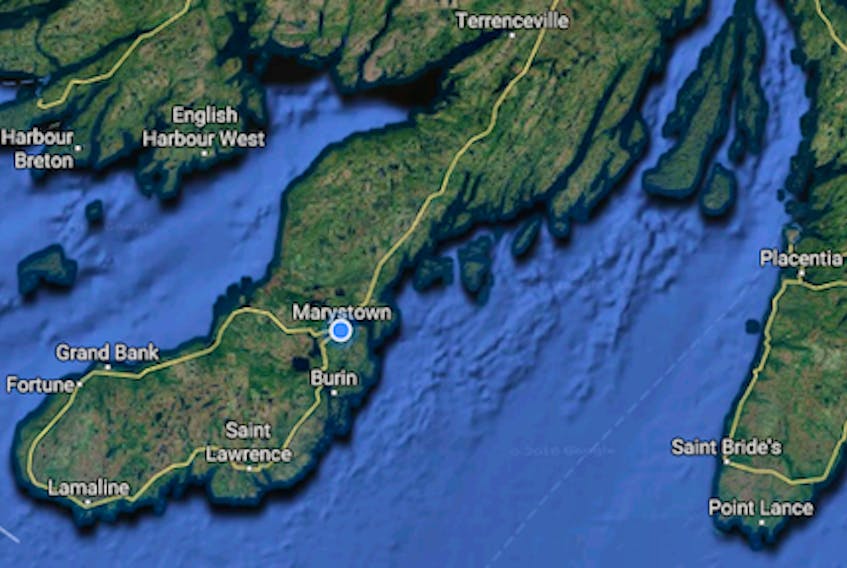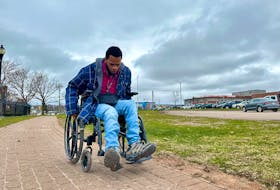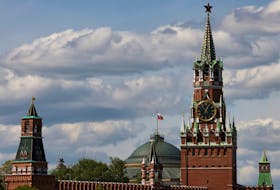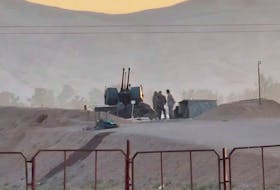MARYSTOWN, N.L. — When Travis Parsons graduated from John Burke High School in the early 2000s, he did so alongside nearly 80 other students from the Grand Bank-Fortune area.
This September, according to the Newfoundland and Labrador English School District, 21 students from the two towns started kindergarten at Lake Academy in Fortune.

It’s a stark contrast.
After experiencing a growing population on the Burin Peninsula, in the late 1980s a U-turn began that picked up steam in the years following the collapse of the cod fishery a few years later. The number of people living on “the Boot” has been trending downwards ever since.
According to census data, the population of the Burin Peninsula in 1986 was 29,360, just over 14,000 of whom fell between the ages of birth and 24. Roughly 8,400 were 14 years old or younger.
Also using Statistic Canada’s figures, Newfoundland and Labrador’s Vital Signs Report 2018, pegged the Burin Peninsula’s population in 2016 at 19,800, a drop of 941 from 2011. Just 4,400 were between the ages of 0-24.
The shrinking population is likely to continue in the coming years.
Alvin Simms and Jamie Ward of Memorial University’s Harris Centre Regional Analytics Laboratory used three different statistical models as part of their Regional Population Projections for Newfoundland and Labrador 2016-2036 report that was published in 2017.
One of them, the historical (cyclical) survival model, which assumes recent age specific birth and death rates continue, and also factors in the migration rates of the past 10 to 15 years, predicts the population of the Burin Peninsula could drop to roughly 15,000 over the next 18 years.
The natural survival model, which depends on recent age specific births and deaths only without including migration, predicts a slower decline to 16,624 by 2036.
The third model, the replacement survival model, estimates the amount of in-migration necessary for the workforce population to be maintained at its current level. The population under that model ranges from 17,829 with low replacement to 18,791 with high levels of replacement.
Concern
Parsons is concerned but not entirely pessimistic about the region’s future.
A small business owner with a full-time job as well, he grew up in Grand Bank, left for a while to attend post-secondary school and was one of the precious few who returned. At 35, he is now raising a young family of his own in his hometown.
If things stay the way they are in the region, he believes the population could continue to drop sharply.
“I think no doubt it’s going to go down anyways. We’re not going to get that much of an influx of people to get back to where we were,” said Parsons, who also served on Grand Bank town council for four years but was not re-elected in last year’s municipal election.
“It’s going to decrease from what it is, for sure.”
That may be alarming, Parsons says, but he thinks if the right people buy in and the proper steps are taken, including following the approach of other regions in the province – like Bonavista, Fogo and Twillingate – the population could stabilize in 10 or 15 years. That process has to start now, though, he says.
“No one is going to come home because they miss mom or they miss the smell of the beach up the cove,” Parsons says. “There’s got to be more to it than that.
“We all love that and that’s a draw for people, but they have to have opportunity and they have to see benefit.”
Big challenge
Simms has had some success predicting the population of the Burin Peninsula before.
He and Ward completed a demographic analysis report for the now-defunct Burin Peninsula Rural Secretariat’s regional council, released in February 2012, that predicted the 2016 population for the region would be 19,395, about 400 fewer than the actual number turned out to be.
Simms says there’s no simple solution to the population slide but suggested year-round jobs that pay living wages is one obvious thing that is needed to attract and retain young people.
“It’s a big challenge,” he says.
Perhaps Grieg NL, the company planning to kick start the aquaculture industry on the Burin Peninsula in a big way with a salmon hatchery in Marystown and sea cages in Placentia Bay, can be one of the key cogs for slowing or reversing the decline in population.
For that to happen, Simms says it’s important then to capitalize on all the potential components that could turn aquaculture into a core industry, like a feed plant and local processing of the fish.
“To me, you have to fight for the full package,” Simms says.
“If you’re growing fish there, you should be able to produce food for the fish there and you should be able to process it there.”
Michael Graham said demographics was a major focus during his tenure as chair of the local Rural Secretariat regional council before it was disbanded along with others in the province by the current Liberal government.

“We need diversity in the economy is what it boils down to, and I mean, things like Grieg may turn that around,” he said.
Graham said he knows of a few young families that have come back to the area because it’s still a great place to live, and Simms acknowledged the region has urban-like services going for it, such as the YMCA in Marystown, hospitals, retail stores, grocery stores and sports facilities.
“You have the attractors, the next attractor is the jobs,” Simms says.
Simms doesn’t see a smaller population for the Burin Peninsula as necessarily a bad thing – if it means the economy is strong, everybody is working and the quality of life is good.
“You may get smaller and you may become more efficient and you may be a well-working machine of a region … with a smaller population, with a very high standard of living because everybody is working,” he said.
Graham says there’s no way to tell what could happen in the future.
“The worst-case scenario is we’re down to 15,000 (people). Yes, there’s going to be services that disappear and things like that, but that’s the worst-case scenario and we don’t necessarily have to go there. There’s a lot of things that could change that.”
The Bonavista blueprint
In addition to jobs and opportunities, Parsons believes other factors could also help stabilize and maybe eventually grow the region’s population.
Fostering a sense of community and improving livability, aspects for which Bonavista has been greatly lauded in the past couple of years, are also very important, he says.
Parsons considers Bonavista as a blueprint for what is possible in rural Newfoundland and Labrador. While the town’s population may have gone down in the 2016 census, the amount of new businesses that have started up in the town and the number of children entering school are encouraging, he says.
“It’s because they’re investing in livability, they’re investing in the small things that as a collective add up,” Parsons said.
“They’re focusing on young families. Instead of one big industry, they’re focusing on attracting people to set up niche businesses that can work in rural Newfoundland.”
“You plant a tree not so you can enjoy the shade, it’s so your kids and grandkids can. That’s the mentality I think we have to have.” — Travis Parsons
Parsons says that can be done in this region, too, but it will require vision and people who see the value in taking the necessary steps.
Young people might be more inclined to have that mentality, he suggests, but unfortunately, they are not nearly as involved in their communities as they should be.
Parsons, who would like to see more diversity for all leadership groups in the region, whether they be town councils, volunteer groups or other, said young people who plan to still be living and working in a community 25 years down the road would make decisions with that in mind.
“You plant a tree not so you can enjoy the shade, it’s so your kids and grandkids can. That’s the mentality I think we have to have.”
Hawkins bullish on rural Newfoundland and Labrador
Advanced Education, Skills and Labour Minister Al Hawkins is confident rural Newfoundland and Labrador has a future.
Providing opportunities and putting the resources in place to ensure communities are sustainable are key to that, he said.

Hawkins said it’s a concern when you see the population is decreasing and the statistics show that more people are dying in the province than are being born. The minister said it means being proactive to improve and reverse the situation.
One way is through immigration, which falls under his portfolio.
“The message we got to get out there is immigrants are not necessarily coming and taking jobs from Newfoundlanders and Labradorians,” he said.
It’s the opposite, Hawkins said, suggesting they are becoming very productive members of communities in the province.
Hawkins said the provincial government’s cabinet committee on jobs has been looking at rural areas. Aquaculture, agriculture, forestry and mining have been identified as among the sectors that are geared more to rural regions as opposed to urban centres, he said.
“It’s an area that we’ve got to continue to focus on because it’s very important for us, particularly smaller communities in order for survival going forward,” Hawkins said.
“Most of these communities expect the same level of services that any other community in the province has and rightly so, and particularly with an aging demographic. We’ve got to sort of mitigate some of the risks that are involved in providing these services and not having the necessary revenue to offset the cost of these services.”
Hawkins acknowledged keeping youth in the province is a challenge, but not one that is necessarily unique or new to Newfoundland and Labrador.
“If you talk to a lot of them, you know, Newfoundland and Labrador is where they want to be and raise a family, and so we just got to make sure we’re doing everything we can to provide those opportunities for young people,” he said.
The Burin Peninsula in 2016
Total population: 19,800
Age 0-24: 4,400
Age 25-64: 10,925
Age 65+: 4,505
Total immigrant population: 170
Total Indigenous population: 295
Source: Statistics Canada
Kindergarten enrolment on the Burin Peninsula for 2018-19
Christ the King School, Rushoon: 7
Donald C. Jamieson Academy, Burin: 35
Fortune Bay Academy, St. Bernard’s-Jacques Fontaine: 3
Holy Name of Mary Academy, Lawn: 4
Lake Academy, Fortune: 21
Sacred Heart Academy, Marystown: 45
St. Anne's School, South East Bight: 0
St. Joseph's Academy, Lamaline: 3
St. Joseph's All Grade, Terrenceville: 5
St. Lawrence Academy, St. Lawrence 8
Source: Newfoundland and Labrador English School District









